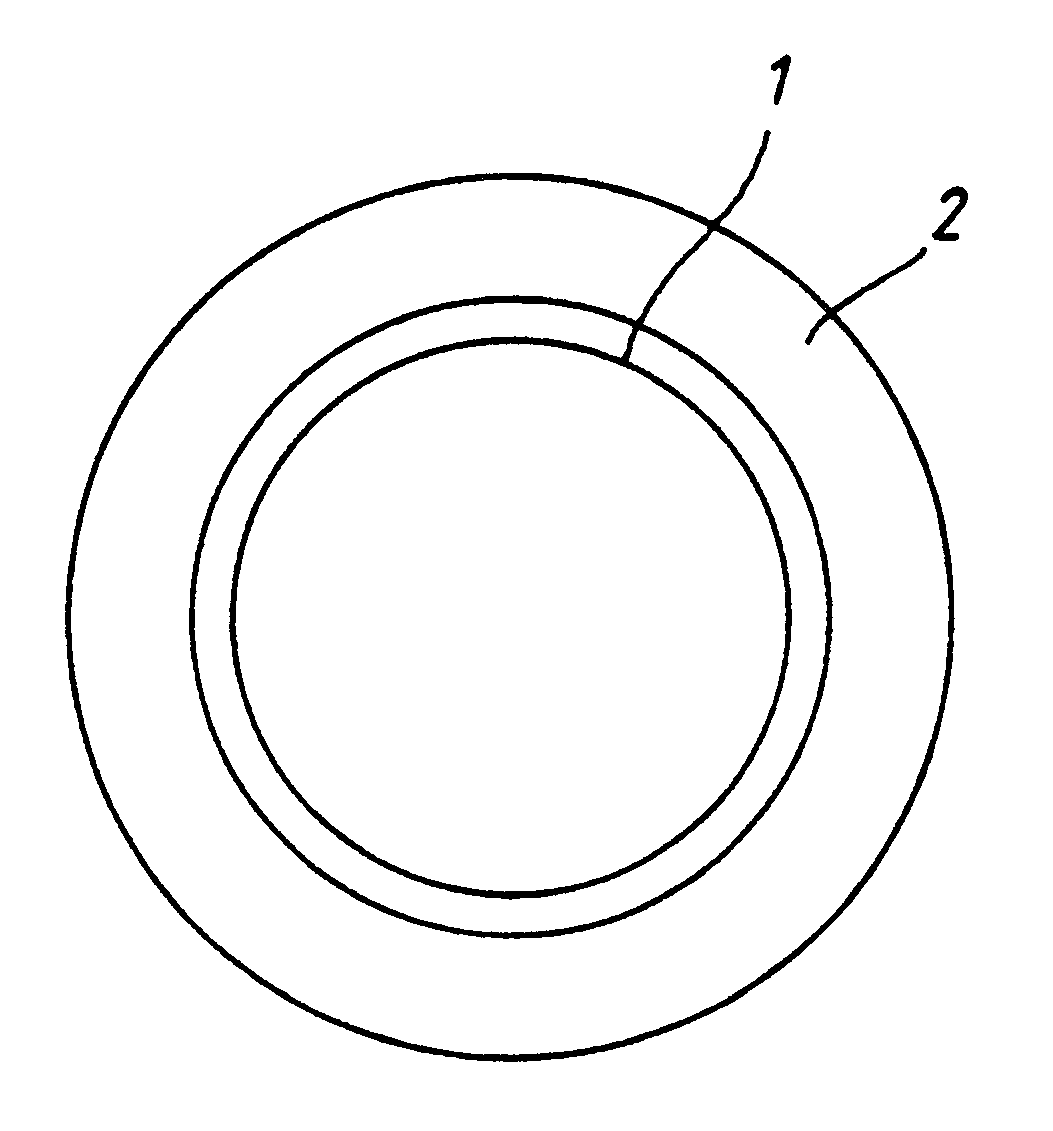| (19) |
 |
|
(11) |
EP 0 385 731 A1 |
| (12) |
EUROPEAN PATENT APPLICATION |
| (43) |
Date of publication: |
|
05.09.1990 Bulletin 1990/36 |
| (22) |
Date of filing: 27.02.1990 |
|
| (51) |
International Patent Classification (IPC)5: F16L 11/127 |
|
| (84) |
Designated Contracting States: |
|
AT BE CH DE DK ES FR GB GR IT LI LU NL SE |
| (30) |
Priority: |
01.03.1989 JP 49526/89
|
| (71) |
Applicant: JAPAN GORE-TEX, INC. |
|
Setagaya-ku
Tokyo 156 (JP) |
|
| (72) |
Inventors: |
|
- Shimoda, Eiji
Musashino-Shi,
Tokyo-To 180 (JP)
- Motada, Akihiro
Okayama-Shi,
Okayama-Ken 703 (JP)
|
| (74) |
Representative: McCallum, William Potter et al |
|
Cruikshank & Fairweather
19 Royal Exchange Square
Glasgow G1 3AE
Scotland
Glasgow G1 3AE
Scotland (GB) |
|
| |
|
| (54) |
Conductive composite plastics tube |
(57) A composite plastics tube is described in which an electrically conductive layer
(1) consisting of a plastics material containing a conductive filler is surrounded
by an insulating layer (2) of plastics material.
|

|
[0001] The invention relates to a composite plastics tube.
[0002] Tubes have an internal passage through which different substances can be transported,
and may be made from a variety of materials, such as metals, ceramics and synthetic
resins, depending on the desired properties and functions of the tube itself and the
physical properties of the substances to be transported.
[0003] For some uses, problems arise in that liquids flowing through the internal passage
freeze or that transport becomes impossible because of increased viscosity even if
freezing does not occur. In these cases it is necessary to heat substances in the
tube efficiently during transport. The invention is concerned with providing a plastics
tube which enables this to be done in a simple and efficient manner.
[0004] According to the invention there is provided a composite plastics tube composed of
at least two different materials, characterized in that one of the materials is a
plastics material containing an electrically conductive filler.
[0005] The filler renders the material electrically conductive so that the tube and its
contents can be heated by passing an electric current through the said material of
the tube.
[0006] A preferred embodiment of the tube in accordance with the invention will now be described,
by way of example, with reference to the sole Figure of the accompanying drawing which
shows a cross-section of the tube.
[0007] The tube shown is of circular cross-section and comprises two different layers, an
inner conductive layer 1 of electrothermic material and an outer insulating layer
2. In this embodiment the conductive inner layer 1 is made of a porous body of ethylene
tetrafluoride resin containing carbon black in an amount of 80% by weight, and the
insulating outer layer 2 is a porous material consisting of ethylene tetrafluoride
resin.
[0008] A tube with this structure is suitable for transporting all types of medicinal products,
and if it includes an innermost layer of a copolymer of ethylene tetrafluoride and
perfluoroalkylvinyl ether it will have good chemical resistance.
[0009] The tube can be used for electrothermic maintenance of temperature and heating liquids
that are being transported, by passage of a suitable electric current through the
conductive layer 1. In addition, such temperature maintenance and heating can be carried
out safely and economically as a result of the adiabatic and electrical insulating
effects of the porous body of ethylene tetrafluoride resin forming the outermost layer
2. By this means, freezing or unacceptable increases in the viscosity of transported
liquids can be prevented. Furthermore, because the resin used in forming the tube
is of extremely high flame-resistance and heat resistance, temperature maintenance
and heating can be carried out at temperatures close to 200
oC.
[0010] A tube as described above can be manufactured by extrusion, using two extruding machines.
One extruding machine is used for ethylene tetrafluoride resin containing carbon black,
and the other extruding machine is used for ethylene tetrafluoride resin alone. Paste
extrusion moulding of these materials is then performed simultaneously using suitable
auxiliary agents and a suitable die to obtain a composite, circular section tube with
a two-layer structure in which the ethylene tetrafluoride resin containing carbon
black forms the inside layer. The auxiliary agents for facilitating the paste extrusion
moulding are subsequently removed from the tube by heating.
1. A composite plastics tube composed of at least two different materials, characterized
in that one of the materials (1) is a plastics material containing an electrically
conductive filler.
2. A composite tube according to claim 1, in which the different materials (1,2) are
arranged in layers one around another.
3. A composite tube according to claim 1 or claim 2, in which a second of the materials
(2) is a plastics material which is the same as that which contains the conductive
filler.
4. A composite tube according to any one of the preceding claims, in which the plastics
material containing the conductive filler is ethylene tetrafluoride resin.
5. A composite tube according to any one of the preceding claims, in which the conductive
filler is carbon black.
